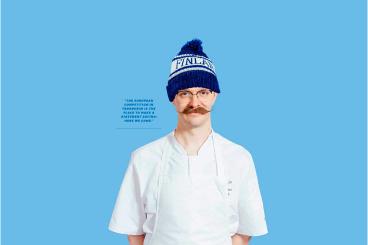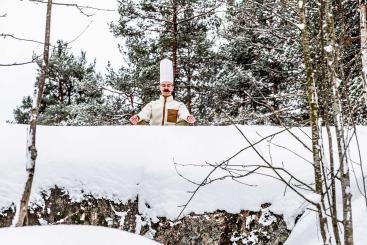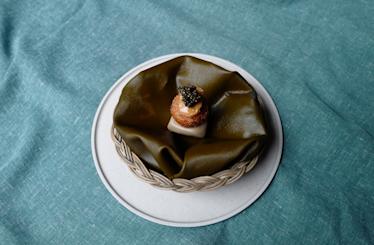
Bocuse d'Or Finland training kitchen, what's cooking?
Tick tock says the clock on Kristian Vuojärvi’s hand as he pushes Team Finland to give their best in training. Let’s take a peek inside the training kitchen.
Julkaistu
Teksti
Mariaana Nelimarkka
Kuvat
Laura Hujanen
Ismo Sipeläinen has dedicated months to his training regimen in Trondheim, aiming to reach his goals. The primary focus of the training is to build confidence and find inner peace.
How does he ensure the kitchen remains a serene place amid a whirlwind of activity? The secret lies in just the right amount of repetition – neither too much nor too little.
As a seasoned competitor, Chef Sipeläinen understands the importance of keeping conditions consistent while making the training engaging. He insists on always keeping the product intriguing, ensuring the skrei cod doesn’t start swimming against the current.
Throughout the training season, Sipeläinen has invested wholeheartedly in maintaining a sense of relaxation and creativity. Creativity is pivotal, especially during repetitive training. The primary aim is continuous improvement, requiring constant vigilance and innovative thinking to do things differently and better. This becomes challenging if everything starts to taste mundane.
Adding momentum to Sipeläinen’s training is the year he recently spent in the kitchen of the Speilsalen restaurant in Norway. This experience has given him a profound understanding of the ingredients used in Norway and insight into what can be created with them.
“The year in Norway is an advantage because the scallop that arrives on the competition day is of a familiar fresh quality; the scallop isn’t the same after being transported to Finland. It’s also fascinating that I visited the Lofoten Islands and witnessed the fish-drying process. In cod we trust,” remarks Sipeläinen.
However, Sipeläinen’s primary training goal is to bring forth his unique vision, clarify it, and ultimately reveal his culinary soul. The kitchen team has already witnessed challenging moments, and one of the most memorable was when a component failed. Sipeläinen celebrated the mishap as a significant success – a true testament to the fact that setbacks are part of training. They teach the team to turn them into victories.
During the practice season, Sipeläinen’s team live in two-day cycles: the first day is for mise en place, and the next is for the competition lift. On mise en place day, they ensure they can approach the competition with peace of mind, perfectly prepared.
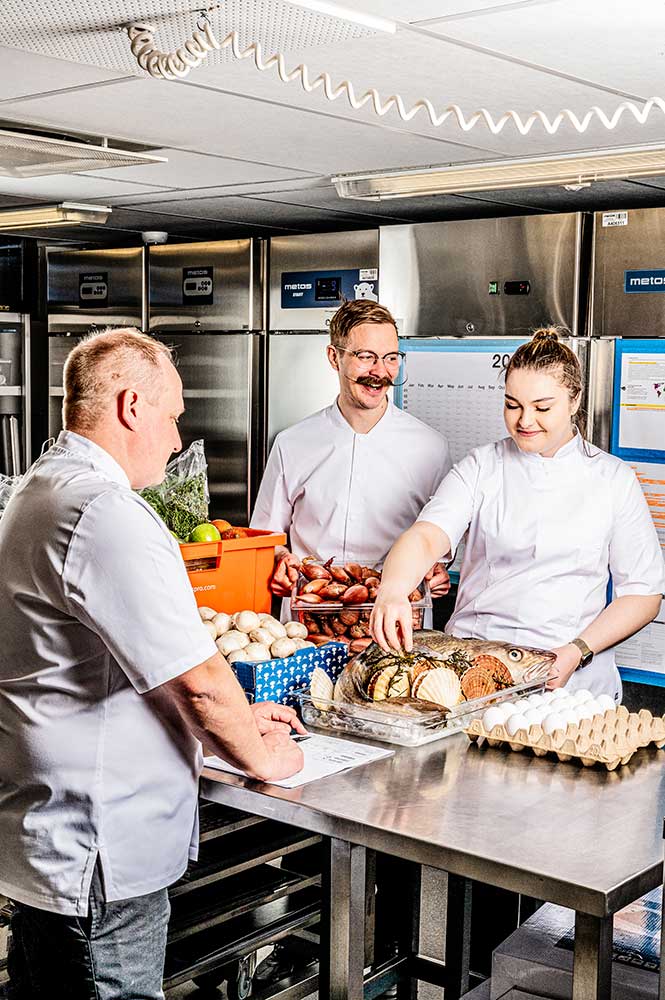
Day 1 – mise en place
The kitchen is a hive of activity on many levels. A lot of groundwork has been laid to focus on weighing and packing on mise en place day. The assistant handles inventory orders, and ingredients are picked up and received. Work overlaps with student assistants preparing for the next training round during competition day.
- 5:45 Wake up
- 7:15 Team breakfast in the kitchen (quick porridge)
- 7:30 Briefing
- 8:00 Review of ingredients. Weighing dry ingredients and liquids. For example, broths have been prepared in advance.
- 10:00 Coffee break
- 10:30 Packing equipment
- 12:00 Lunch
- 12:30 Updating lists,making changes
- 13:00 Preparing and packing herbs
- 15:00 Coffee break
- 15:30 Review of the competition performance
- 17:00 Everything in place for the morning, ready for the competition day.
- 18–20 Leave the kitchen and try to recover for the next day.
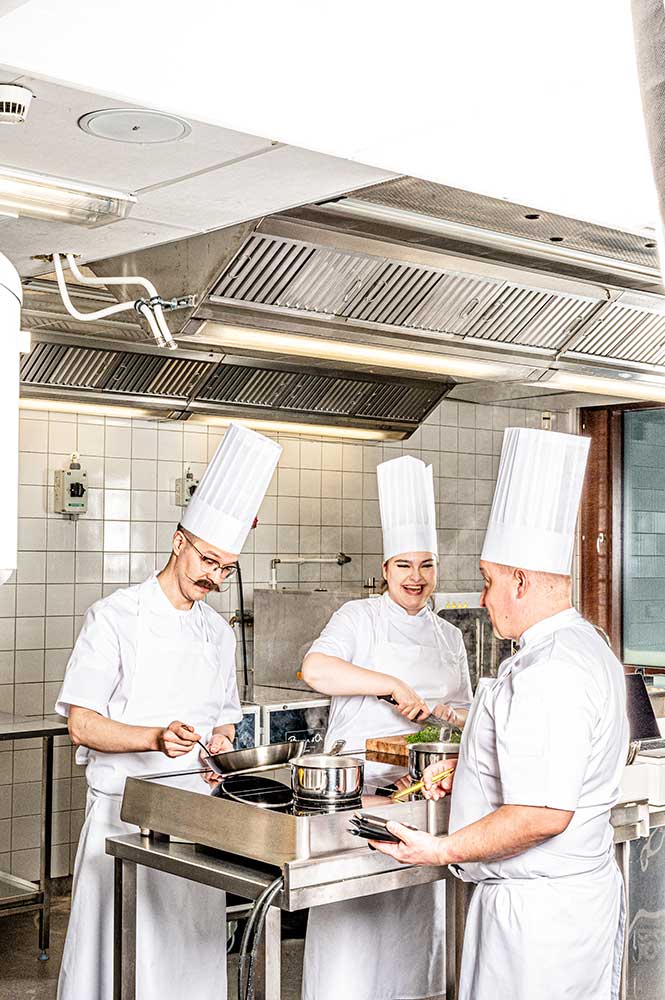
Day 2 – Timing
The flow of the competition day is simulated in the training kitchen. Since all actions are meant to be automated, routines are strictly adhered to. The kitchen setup also mirrors that of the competition box.
- 5:45 Wake up
- 6:30 Departure from home to the training kitchen
- 7:00 “At the competition venue.” The logistics team unloads equipment in the loading area. This doesn’t happen in every training session, but just before heading to Trondheim, this part is also simulated.
- 8:10 Taking control of the kitchen, crossing the threshold, and bringing items and ingredients into the kitchen.
- 10:10 The clock is ticking! Starting the competition performance. Ismo starts with the main ingredients, Kaisa with the side dishes.
“In the first few minutes,I take a soft landing in the kitchen to let the stress spike settle. For example, I don’t immediately pick up a knife but rather perform tasks where it’s not possible to cut a finger. It’s better to start with some secondary tasks because the first cuts are critical, especially in tasks like preparing fish,” Ismo explains.
From this point on, the training day schedule and adherence to it are in the hands of the coach Kristian Vuojärvi.
The mandatory ingredients, reindeer shank, inner sirloin, and tongue, receive attention as soon as the task begins, even though there is still time before serving. Sipeläinen adds Linie Aquavit, a mandatory ingredient, to the accompaniment. The candidate also takes care of the cod, haddock, and scallops right away.
- 15:05 4 hours 55 minutes after the start, the reindeer dish is ready. The candidate and assistant raise their hands to indicate that their dishes are complete.
- 15:40 5 hours 30 minutes from the start, the fish dish is ready. The candidate and assistant raise their hands to signal that the dish is complete. The presentation and serving of the fish dish crown the day.
- 16:40 Kitchen cleaned. In the actual competition, the kitchen judge checks the kitchen.
- 17:00 Car packed with the assistance of the logistics team. This is not done in daily training sessions, but the idea is that everything is packed at this point in the day.
- 17:00 Team review: How did it go? Feedback discussion among the team. This is part of the programme every day, as it is the most important moment of the day, especially from the coach’s perspective.
”Trondheim’s second main ingredient is reindeer, and it’s fantastic to have such a high-quality ingredient for the European qualifiers. Initially, we were a bit puzzled, as reindeer is familiar to us, but it’s a challenging ingredient. It’s not familiar to Central Europeans, so reindeer was a special curveball we didn’t expect,” Ismo Sipeläinen describes his initial impressions in January.
Me Kesprossa autamme kaiken kokoisia asiakkaitamme menestymään sekä kehittämään liikeideaansa. Meiltä saat palvelua niin henkilökohtaisesti kuin digitaalisissa kanavissa.
Tule asiakkaaksiAsiakkaanamme käytössäsi on Suomen laajin tukkuvalikoima Kespronet-verkkopalvelun kautta. Logistiikka - ja jakeluverkostomme kattaa koko Suomen.
Tilaa Kespronetistä